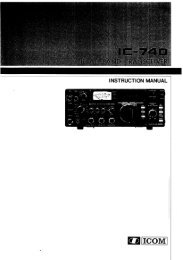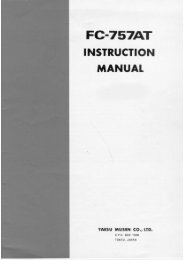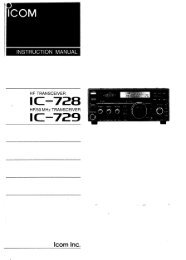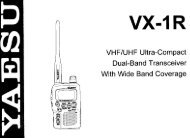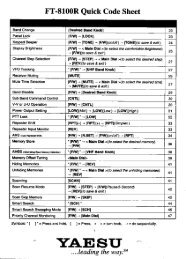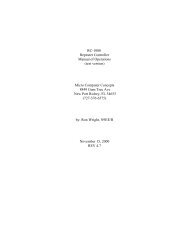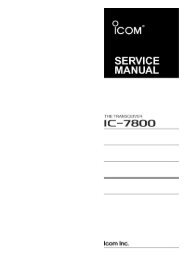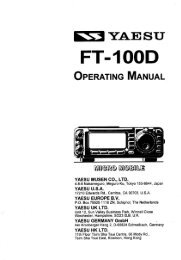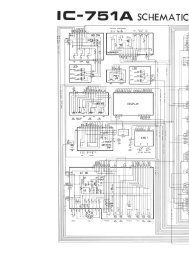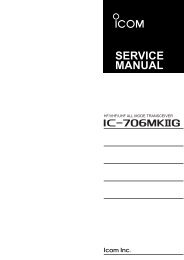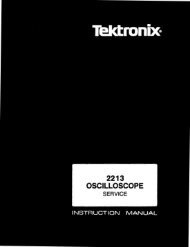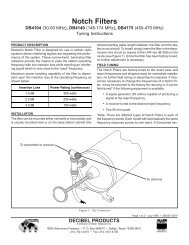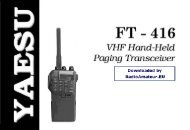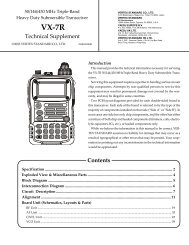Lightning Protection for Ham Radio Stations
Lightning Protection for Ham Radio Stations
Lightning Protection for Ham Radio Stations
Create successful ePaper yourself
Turn your PDF publications into a flip-book with our unique Google optimized e-Paper software.
<strong>Ham</strong> <strong>Radio</strong> Station <strong>Protection</strong>Document ID: PEN1016Page 37of 11occur. Most basements have concrete floors. Since concrete is a conductor, your equipment must not sitdirectly on the concrete. Doing so will allow surge energy to enter the shack and find a ground path throughyour equipment to the floor. Insulate your equipment with material that does not absorb water. Wood is nota good choice. Polypropylene is better than nylon to use as a full footprint sheet insulator. Obviously, youshould not be on the concrete floor touching the equipment when a storm is near!The first floor is the next best location. The magnetic shielding is less than the basement and the inductanceto ground is higher than the basement. If your tower is close to the building, the recommended groundingstrap, running down the outside wall, may inductively couple some energy from the tower. This is also true <strong>for</strong>other lines such as coax, tower lights and rotor lines. The longer this parallel run, the more energy will becoupled. Our recommendation is to protect these lines at the tower base then run them in EMT (electricalmetal tubing) steel conduit. The conduit should be grounded to the tower base ground point. This will act asa faraday shield <strong>for</strong> the cables inside. Do not run unprotected lines in the EMT. The protectors must begrounded to each other as well as to the tower ground. The best way to do this is to place the protectors insidea weatherized NEMA type box. Make sure the box is grounded, as well as the inside mounting plate. To dothis correctly, remove the paint from the box’s outside and inside surfaces at the ground point and use properjoint compounds to weatherize the connections. Stainless hardware may be used. Crimp lugs must be crimped,soldered and weather covered. Solder (60/40) will not hold up to sunlight and ozone without protection. Usea short section of strap to bond between the inside surface of the box and the inside protector mounting plate.High Rise BuildingsOur definition of a high rise building is different than the upper stories of a house. The antennas on a high riseare not on a ground mounted tower, but are usually attached to the building structure. There<strong>for</strong>e, a single pointgrounding plan is a must <strong>for</strong> a high rise equipment room. Grounding both the antenna and the single pointground connection in the equipment room is easy <strong>for</strong> buildings with structural steel frames - just bond to thebuilding steel. Buildings other than steel construction are not as simple. Some high rise buildings have a fireriser with a straight run to the basement where a super charger pump is usually connected. The riser may beused as a ground path if the pump’s power is protected and a strap jumper installed to take the strike energypast the pump’s gasket on both its input and output ports. If the riser is over 50 feet away, it may not be thebest ground path to use. Check <strong>for</strong> other paths such as existing building lightning rods with down conductorsor large electrical conduits. Do not use drain pipes or vent stacks. If none are available, regardless of the pathdistance, and it is impossible to run a strap down the side of the building, then the antenna just can’t begrounded! When an ungrounded antenna is hit by lightning, the energy will traverse the coax line to your singlepoint equipment ground location. This may be many meters from earth and the inductance/ resistance voltagedrop will be very large (hundreds of thousands of volts).The ideal plan is a single point ground with no sneak paths. Sneak paths are loops that allow lightning currentto flow into the equipment room. The easiest sneak paths to miss are the safety ground and the concrete floor(discussed above). The safety ground can be fixed by adding a distribution panel and protector at the single



